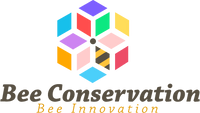The ongoing debate between beekeeping and environmental circles, - pros and cons of wild bees versus honey bees. Some argue that honey bees' success can deplete resources for wild bees, creating a biodiversity tug-of-war. Conservationists lean towards wild bee focus, while others believe more bees mean more pollination and better biodiversity. Both bee types face losses, making distinctions less helpful.
Social Structures: Bees fall into three categories—solitary, social, and kleptoparasitic. Solitary bees live and forage alone, while honey bees are highly social, specialising in labor roles for efficiency.
Foraging Range: European honey bees cover vast distances of 1 to 8 km for food, whereas solitary bees travel shorter distances, concentrating their pollination efforts.
Pollination Preferences: Bees are divided into pollen specialists and generalists. Specialists focus on specific plants, while generalists, including honey bees, collect from various sources, extending their foraging season.
Wild Bee Diversity: With over 20,000 bee species worldwide, categorising all wild bees as a single group lacks precision, limiting applicability across ecosystems.
The elephant buzzing around the room
The good news is wild bees and honeybees coexist very well. Honeybees are generalists — they will forage across a wide range of plants, both native and exotic. Native bees, however, are often species-specific with what plants they visit. Since they tend to gravitate toward slightly different foraging areas, the presence of honeybees does not necessarily exclude native bees, especially in areas designed to attract both. In this regard, native and non-native bees do not heavily compete against each other — assuming there is enough variation in vegetation to provide for both their needs.
both wild and honey bees are vital for global ecosystems. However, the impact of both bee types depends on the specific ecosystem. A balanced approach is crucial, recognising that what works in one area may not apply elsewhere. Bee populations, like our world, are wonderfully complex, and our goal should be a healthier, more diverse environment for all.
#BiodiversityMatters #Sustainability #MissionZero2031 #BeeTheChange #beeconservation #beeinnovation #environment #sustainability #environmentalmanagement #greenestatemanagement #honey #environmentalconsulting #beehive #beehiverental #wellness #pollination #pollen #ecology #ecological #biodiversity #habitat #sustainabledevelopment #biomonitors #environmentalmonitoring #bees #beeswax
Honey bees and wild pollinators differ in their preference for and use of introduced floral resources
Christine Urbanowicz, Paige A. Muсiz, Scott H. McArt, 2020
https://onlinelibrary.wiley.com/doi/full/10.1002/ece3.6417

